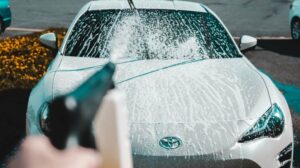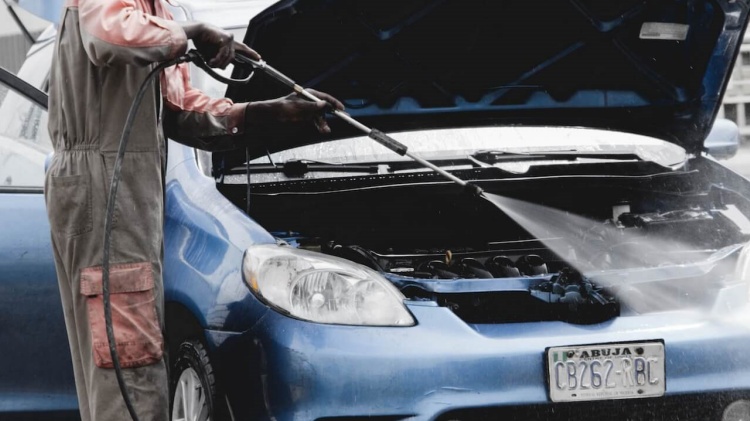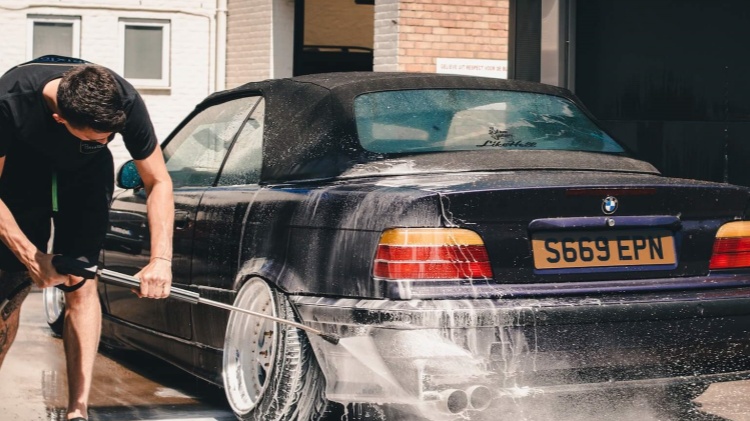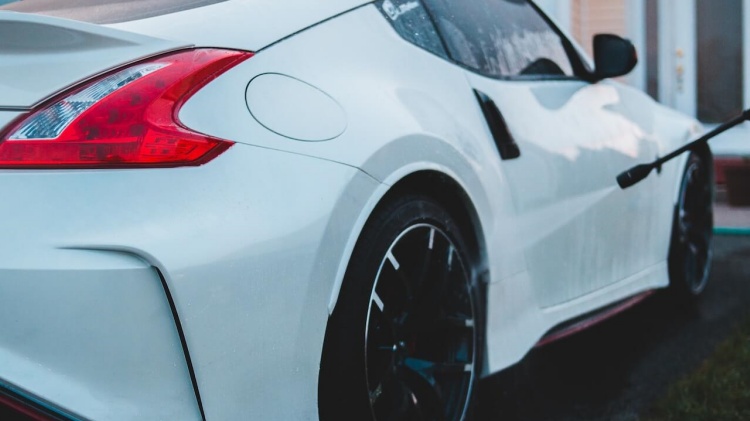
The Dos and Don’ts of Cleaning Your Car with a Cordless Pressure Washer
Cordless pressure washers provide an easy and effective way to clean your car at home. Their portability allows you to quickly blast away dirt and
Cordless pressure washers are a convenient and portable way to tackle outdoor cleaning tasks. However, like any power tool, they can develop issues that prevent them from working properly. In this blog post, we’ll explore some of the most common problems with cordless pressure washers and provide troubleshooting tips to get your washer back up and running.
Most problems with cordless pressure washers stem from battery and charging issues. Here are some things to check:
If your charged battery is not providing sufficient power, here are some things to investigate:
Corrosion on the battery terminals can impede power transfer. Clean the terminals on the battery and pressure washer with a wire brush or sandpaper to reveal shiny metal.
Wiggle the battery in the pressure washer to ensure it makes a tight connection. The connectors should be firmly joined. Loose connections result in power loss.
Use a voltmeter to test battery voltage. Compare it to the voltage listed in the pressure washer manual. If lower, the battery needs replacement.
Turn the pressure washer off and disconnect the battery. Wait a minute, then reconnect and turn it on. This may clear any glitches affecting power.
If the battery is more than 2–3 years old and other troubleshooting hasn’t worked, replacing the battery with a new one is likely needed. Purchase a battery recommended for your model.
The electric motor converts the battery’s power into pumping pressure. Here’s how to keep it running optimally:
Prevent debris like dirt, leaves, and sediment from being sucked into the pressure washer inlet. Debris can damage the motor. Use an inlet filter if provided.
Make sure the nozzle opening is clear and not clogged. If the flow is obstructed, the backpressure on the motor will reduce performance.
Shut off the motor and allow it to cool if the pressure washer is used continuously beyond the recommended duty cycle time stated in the manual. This prevents overheating.
Don’t leave the pressure washer outside exposed to rain, snow, and temperature extremes, which can corrode and damage the motor over time.
Keeping the motor debris-free and in optimum operating conditions will enable it to convert battery power most efficiently.
Insufficient water pressure from your cordless washer indicates an issue preventing the pump from building up pressure. Here’s how to get the pressure back:
Make sure the nozzle opening is clear and not obstructed. Even small blockages severely reduce outlet pressure.
A clogged inlet filter starves the pump of water, resulting in low pressure. Remove and clean the filter regularly.
Listen to air leaks around pump connections and fittings. Tighten fittings or replace leaky seals and o-rings to prevent pressure loss.
Kinks, blockages, and debris in the hoses can impede water flow and reduce pressure. Straighten hoses and flush them with water to clear obstructions.
Disconnect the hose and trigger the pump briefly to verify strong pressure directly out of the pump. Weak pressure indicates an issue with the pump itself.
Worn pump seals allow water to leak inside the pump, undermining pressure production. Seal kits are available for many pump models. Follow instructions closely when replacing seals.
Identifying and addressing what’s inhibiting pressure generation will restore your cordless pressure washer to full cleaning power.
The pump needs a sufficient and steady stream of water to generate pressure. Here are some tips for providing adequate water flow:
Hose length greatly affects the water supply to the pump. Use the shortest hose possible between the inlet and the water source for the best flow.
Standard garden hoses may not deliver water fast enough. Use high-flow pressure washer hoses or hoses with a minimum 3/4″ diameter.
Kinked and twisted hoses significantly restrict water flow. Ensure the hoses are straight without tight bends.
Pressure washers draw hot water more easily than cold water. A connection to the hot water outlet is available for a boost in flow rate.
Standard outdoor faucets may not support a pressure washer’s water demands. Install higher-flow outlets optimized for pressure washers.
Add a booster pump
For weak water supply, add a booster water pump to the inlet hose to increase water volume to the pressure washer.
Providing abundant water flow to the inlet is key to enabling the pressure washer pump to deliver strong cleaning pressure.
To keep your pressure washer operating at peak performance, it’s important to properly maintain and protect the water system components. Here are some tips:
After each use, flush the system with clean water to rinse out chemical residue and loose debris that can cause corrosion and clogging.
Examine the inlet filter regularly and clean it when debris is visible. Clogged filters reduce water supply.
Adding RV antifreeze or pump protector fluid to the system for storage prevents freeze damage and lubricates seals.
In areas where temperatures drop below freezing, fully drain and purge the pump of all water to prevent ice damage to seals and hoses.
If you have hard water, use a water-softening system to reduce mineral deposits that can clog outlets and coat pump components.
Taking steps to properly clean and protect the water system will pay off with a longer-lasting and better-functioning pressure washer.
Follow these general guidelines for keeping your cordless electric pressure washer running smoothly for years to come:
Fully understanding how to use and maintain your model properly will prevent many issues. Keep the manual handy for reference.
Recharge after every use. Store it indoors in a temperature-controlled environment. Never leave in freezing temperatures. Replace it when the charge begins fading.
Remove dirt, debris, and standing water after each use to prevent system corrosion and freezing pump damage.
Add pump protector fluid when storing for extended periods to lubricate seals and prevent hard water mineral deposits.
Inspect seals around the pump periodically for leaks and proactively replace worn seals to prevent pressure loss.
Keep your pressure washer sheltered when not in use to avoid damage from the sun, rain, wind, and temperature extremes.
By caring for both the power and water systems and practicing regular maintenance, your battery-powered pressure washer will deliver years of reliable cleaning performance.
Here is a quick troubleshooting guide summarizing potential issues and solutions for cordless electric pressure washers:
No pressure:
Weak pressure:
Pressure drops during use:
Pressure washer won’t turn on:
Battery won’t charge:
Water leaks:
Following the troubleshooting tips in this guide will help you quickly identify and resolve any issues that arise with your cordless electric pressure washer. With proper maintenance and care, you can enjoy lasting performance and make quick work of all your cleaning projects.


Cordless pressure washers provide an easy and effective way to clean your car at home. Their portability allows you to quickly blast away dirt and

Cordless pressure washers make cleaning outdoor surfaces much easier thanks to their portability and powerful cleaning action. If you’re new to pressure washing, it can

Owning a cordless pressure washer is a great way to keep the exterior surfaces of your home clean. With the right maintenance, you can maximize

A cordless pressure washer is a versatile tool that makes outdoor cleaning tasks much easier. With its convenient cord-free operation, a cordless pressure washer can

Cordless pressure washers are a convenient and portable way to tackle outdoor cleaning tasks. However, like any power tool, they can develop issues that prevent

Cordless pressure washers provide an easy and effective way to clean your car at home. Their portability allows you to quickly blast away dirt and

Cordless pressure washers make cleaning outdoor surfaces much easier thanks to their portability and powerful cleaning action. If you’re new to pressure washing, it can

Owning a cordless pressure washer is a great way to keep the exterior surfaces of your home clean. With the right maintenance, you can maximize
Copyright © 2024 cordlesspressurewashers. All Rights Reserved.